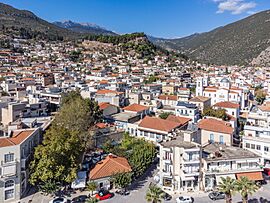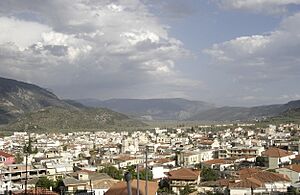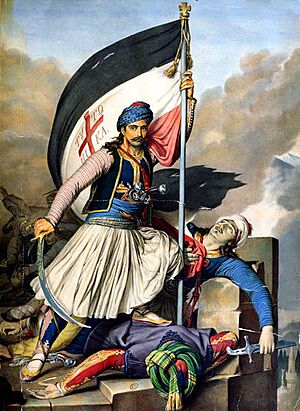Amfissa facts for kids
Quick facts for kids
Amfissa
Άμφισσα
|
|
|---|---|

View of Amfissa.
|
|
| Country | Greece |
| Administrative region | Central Greece |
| Regional unit | Phocis |
| Municipality | Delphi |
| • Municipal unit | 315.174 km2 (121.689 sq mi) |
| Lowest elevation | 180 m (590 ft) |
| Population
(2021)
|
|
| • Municipal unit | 7,761 |
| • Municipal unit density | 24.6245/km2 (63.777/sq mi) |
| Community | |
| • Population | 6,334 (2021) |
| Time zone | UTC+2 (EET) |
| • Summer (DST) | UTC+3 (EEST) |
| Postal code |
331 00
|
| Area code(s) | 22650 |
| Vehicle registration | AM |
Amfissa (in Greek: Άμφισσα, pronounced AM-fee-sah) is an old town in Phocis, Greece. It's part of the Delphi area and is the main town there. Amfissa is located in a beautiful spot, surrounded by mountains like Giona and Parnassus. It's about 200 kilometers (124 miles) northwest of Athens.
Amfissa has a very long history, going back about 3,000 years! It was once the biggest and most important city in the Phocis region. In ancient times, it was a powerful city for the Ozolian Locrians, an ancient Greek tribe. Later, during the Middle Ages, it was known as Salona. The city faced many challenges, including being conquered and destroyed several times. However, it always bounced back and played a big role in the Greek War of Independence.
Contents
Why is it called Amfissa?
The name Amfissa (Άμφισσα) likely comes from an ancient Greek word, amfiennymi. This word means 'to surround', which makes sense because the city is surrounded by mountains.
There's also a cool story from Greek mythology. A woman named Amfissa, who was the daughter of Macar and a friend of the god Apollo, is said to have given her name to the city.
During the 13th century, when the Franks ruled parts of Greece, Amfissa was captured. It was renamed La Sole, and later became known as Salona in Greek. But in 1833, after Greece became an independent country, the city got its ancient name, Amfissa, back.
A Look at Amfissa's History
Amfissa has a rich past, full of important events.
Ancient Times: A Strong Greek City
Amfissa has been settled since ancient times. It was the main town for the Locrians, an ancient Greek tribe. It was known as a beautiful and well-built town, not far from Delphi.
Ancient writers like Pausanias mentioned interesting things about Amfissa. He wrote about tombs, including those of Amfissa and Andraemon. There was also a temple dedicated to the goddess Athena on the city's highest point, called the acropolis. Inside, there was a bronze statue said to have come from Troy. The people of Amfissa also held special ceremonies for "anaktes boys," who might have been the Dioskouroi (twin heroes).
Recent digs have found a Mycenaean tomb in Amfissa. This shows that people lived here a very long time ago, from the 13th to the 11th century BC.
Archaeologists have found signs that Amfissa traded a lot with other cities like Corinth around the late 8th century BC. By the 7th century BC, Amfissa became a proper city-state (a polis). It became very good at arts and trade for about 300 years. Parts of the old city walls still stand today, dating back to the 7th or 6th century BC. In 653 BC, some people from Amfissa even moved to Southern Italy and started a new town called Epizephyrian Locri.
Amfissa had its own unique calendar and coins. Their coins often showed the head of Apollo on one side and the city's name, a spearhead, and a boar's jawbone on the other.
After the Greeks lost the battle of Thermopylae to the Persians, Persian armies invaded many Greek regions. Amfissa's strong acropolis became a safe place for people from other areas. During the Peloponnesian War, Amfissa sided with Sparta, which influenced other nearby towns to do the same. Amfissa was usually ruled by a small group of powerful people (an oligarchy), similar to Sparta.
In 426 BC, a Spartan general named Eurylochus passed through Amfissa. The people of Amfissa agreed to let him pass and even convinced other Locrian cities to do the same. Later, Amfissa became allies with Thebes. In 395 BC, the Thebans encouraged Amfissa to collect taxes from lands that were also claimed by Phocis. This led to a fight, and the Phocians invaded Amfissa's territory.
These conflicts eventually led to the Corinthian War. Amfissa fought alongside Athens, Argos, Corinth, and Thebes against Sparta.
During the Third Sacred War (356 – 346 BC), the people of Amfissa, who were allies of Thebes, started farming on land that belonged to Delphi. They also built pottery workshops in Kirra. In 339 BC, the Athenians put up golden shields at the Temple of Apollo in Delphi with messages that insulted the Thebans. This made the Amfissians angry. An Athenian leader, Aeschines, then accused Amfissa of illegal actions on the sacred lands of Delphi. This led to Philip II of Macedon being called in to help.
In 338 BC, Philip attacked and destroyed Amfissa in what became known as the Fourth Sacred War. He forced many people to leave and gave the land to Delphi. Later that year, Amfissa joined Athens and Thebes in fighting against the Macedonians.
The Amfissians worked hard to rebuild their town and make it strong again. But in 322 BC, it was attacked by Alexander of Aetolia. In 279 BC, 400 Amfissian soldiers helped defend Delphi against the Gauls. Amfissa and the Aetolians became close allies. In 250 BC, Amfissa joined the Aetolian League.
In 245 BC, Aratus attacked Amfissa. Later, the Aetolians and Amfissians allied with the Romans against Philip V of Macedon. After winning, the Roman general Titus declared Amfissa an independent city, free from taxes. It became the capital of Ozolian Locris, with its own council and coins.
However, when the Aetolians realized Rome wanted to control Greek cities, they asked Antiochus III the Great for help. The Roman general Manius Acilius Glabrio then attacked Amfissa in 190 BC. The Amfissians bravely defended their city, trusting their strong acropolis and walls. Athenian leaders stepped in and helped create a truce, saving Amfissa from a full siege.
Between 174 and 160 BC, Amfissa was damaged several times during conflicts. When the Roman emperor Octavian founded the city of Nicopolis, he moved many Aetolians there, but some came to Amfissa. This is why Pausanias mistakenly thought all Amfissians were Aetolian. By the 2nd century AD, Amfissa was a thriving town with about 70,000 people.
Middle Ages: Challenges and New Names
In the early Middle Ages, Amfissa suffered from invasions by groups like the Visigoths and the Huns. In 451, it likely had a bishop. Around 530, Emperor Justinian I strengthened the fortresses in the area, including Amfissa's.
From the mid-9th century, the Bulgars attacked the Phocis region and besieged Amfissa many times. The worst attack was in 996, when Samuel of Bulgaria destroyed the town and killed many people. In 1059, the Pechenegs also besieged Amfissa, forcing its people to hide in caves. In 1147, the Normans arrived but left Amfissa untouched, perhaps because the town was in decline.
In 1205, after the Fourth Crusade, the Franks took over Central Greece. Amfissa became the center of a new lordship under Thomas I d'Autremencourt. The new rulers built the strong Castle of Salona on the old acropolis hill. This is when the town's ancient name was replaced by Salona (or La Sole in French). In 1311, the Catalans conquered and ruled Central Greece for over 80 years.
Ottoman Era and Greek Independence
The Ottomans conquered the Salona region in 1394. In 1580, a huge earthquake destroyed many towns, including Salona. After a short period of Venetian rule (1687-1697), Salona went back to the Ottomans. Many travelers visited the town, which had about 6,000 people. Salona had lost its ancient glory, and some visitors even mistook it for ancient Delphi.
In the 18th century, Salona became a key place for planning the fight against the Ottoman Turks in Central Greece. This was because of its good location and its closeness to the klephts (Greek fighters) in the Giona and Parnassus mountains.
During the Greek War of Independence, Salona was the first town in Central Greece to revolt. Leaders like Panourgias, Giannis Diovouniotis, Ioannis Gouras, and Bishop Isaiah worked together with other heroes like Athanasios Diakos and Yannis Makriyannis. On March 27, 1821, Panourgias attacked the town. On April 10, the Greeks captured the Castle of Salona. This was the first fortress to fall into Greek hands, and they defeated the Ottoman soldiers inside.
From November 15-20, 1821, a meeting was held in Salona. Important local leaders and military chiefs attended. They created a first constitution for the region, called the "Legal Order of Eastern Continental Greece." They also set up a governing council. Salona became the capital of Eastern Continental Greece. This government lasted until the Ottomans recaptured East Greece in 1825.
Culture and Places to See
Amfissa has a rich culture, thanks to gifts from generous people like Markidis, Giagtzis, and Stallos.
Some important landmarks include:
- The Castle of Salona, also known as the Castle of Oria. This is where the ancient acropolis once stood.
- The Archaeological Museum of Amfissa, where you can see artifacts from the past.
- The Annunciation Cathedral, which has beautiful murals by Spyros Papaloukas.
- Several smaller museums.
- The Charmaina district, where traditional bells are still made.
The Municipal Library of Amfissa, founded in 1957, has many books and a collection of traditional paintings from Phocis.
Other old and interesting sites are:
- The Byzantine Savior Church, built in the 11th century.
- A paleochristian baptistery from the 3rd century, next to the Cathedral.
- Lykotrypa, a Mycenaean tomb on the eastern side of town.
- The Folklore Museum of Amfissa.
Amfissa also has a college (TEI), a vocational school (IEK), and a high school (lyceum).
If you love nature, there are many chances for hiking and camping in the nearby mountains. The town has several public squares (plateias), an ancient-style theater (odeon), a choir, and a public band (philharmonic). Amfissa is also famous for its yearly carnival celebration!
Historical Population
| Year | City population | Municipal unit population |
|---|---|---|
| 1981 | 7,156 | – |
| 1991 | 7,189 | 9,469 |
| 2001 | 6,946 | 9,248 |
| 2011 | 6,919 | 8,370 |
| 2021 | 6,334 | 7,761 |
Climate
Amfissa has a hot-summer Mediterranean climate. This means it has hot, dry summers and mild, wet winters.
| Climate data for Amfissa (168m) | |||||||||||||
|---|---|---|---|---|---|---|---|---|---|---|---|---|---|
| Month | Jan | Feb | Mar | Apr | May | Jun | Jul | Aug | Sep | Oct | Nov | Dec | Year |
| Mean daily maximum °C (°F) | 12.3 (54.1) |
14.8 (58.6) |
18.1 (64.6) |
19.9 (67.8) |
26.5 (79.7) |
31.7 (89.1) |
34.1 (93.4) |
34.6 (94.3) |
30.6 (87.1) |
25.3 (77.5) |
19.5 (67.1) |
15.7 (60.3) |
23.6 (74.5) |
| Mean daily minimum °C (°F) | 2.2 (36.0) |
3.1 (37.6) |
5 (41) |
7.4 (45.3) |
10.9 (51.6) |
16.7 (62.1) |
21.1 (70.0) |
22.1 (71.8) |
18.6 (65.5) |
12.4 (54.3) |
10.1 (50.2) |
6.5 (43.7) |
11.3 (52.4) |
| Average precipitation mm (inches) | 134 (5.3) |
34.7 (1.37) |
41.5 (1.63) |
40.3 (1.59) |
33.6 (1.32) |
9.9 (0.39) |
29.7 (1.17) |
29.9 (1.18) |
82.2 (3.24) |
43.6 (1.72) |
55 (2.2) |
73.5 (2.89) |
607.9 (24) |
| Source: http://penteli.meteo.gr/stations/amfissa/ (2019 – 2020 averages) | |||||||||||||
Notable People
- Christos Karouzos, a famous archaeologist.
See also
 In Spanish: Ámfisa para niños
In Spanish: Ámfisa para niños





